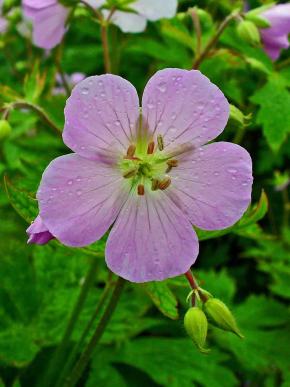Geranium Maculatum
Geranium maculatum is commonly known as Wood Geranium, Wild Geranium and Spotted Geranium. It is a wild geranium species that belongs to the genus Geranium (Cranesbills). Geraniums, Pelargoniums (scented geraniums) and Erodiums are members of the Geraniaceae family.

Photo: Llez
Geranium maculatum is an herbaceous perennial that is native to eastern North America and Canada. In Europe, this geranium species is known as Wild Cranesbill and Spotted Cranesbill. Yet, it is not the same (but very much alike) as the Geranium sylvaticum (Wood Cranesbill, Woodland Geranium) that is native to Europe.
The Spotted Geranium is, like many other geranium species, a popular garden plant and several hybrids and varieties have been cultivated.
It is actually a true delight for every garden!
It is a tough and all round plant that does not need much care and is very easy to grow.
Because this is a wild species, this plants fits very well into a near-natural garden and wild garden and is a superb food and nectar plant for insects like butterflies, bees, bumble bees, flies, beetles and others. Furthermore, various birds and as well as chipmunks love to feed on the ripe seeds!
The flowers are soft pink to rosy-lavender in colour with delicate veins barely visible. The beautiful foliage has palmate-lobed leaves that are mid green in colour. The plants bloom from late spring to mid summer and grow in large clumps that are up to 60 centimetres tall (about 24 inches).
The seeds in the longish seed capsules (hence the name “cranesbill”) are ripe in early summer. Collect the ripe seeds and store them in appropriate bags if you want to grow them from seeds (see below).
Geranium maculatum plants like to grow in the shade especially at the base of trees, shrubs and hedges. They also make excellent border plants!
The plants are tough but they dislike very dry soils and they go dormant under dry conditions. Keep the preferably humus-rich soil evenly moist and water the plants when it is needed, but do not overwater them!
The plants are cold resistant and therefore winter hardy. You do not have to cover them for protection during winter season.
The plants are also very disease resistant.
Propagation: The seeds are best direct sown outdoors in fall. You can grow the seeds also indoors during wintertime in an unheated cellar room or greenhouse. The plants are easily propagated by division of the rhizomes and bulbs or by basal cuttings from the crown.
Cultivated Geranium Maculatum Hybrids Include:
G. maculatum 'Beth Chatto'
This is a hardy perennial with lilac flowers and a mid-green foliage with fingered leaves.
G. maculatum 'Elizabeth Ann'
'Elizabeth Ann' has bronze-coloured leaves, a reddish stem and bluish to lavender-coloured flowers that grow upright and as singles. It grows vigorously and flowers from spring to summer and reflowers sometimes in autumn.
G. maculatum 'Album' (albiflorum)
This subspecies has white flowers.
G. maculatum 'Espresso'
This hybrid has maroon-leafs and lavender-coloured flowers. It blooms from early spring to early summer.
Good for Butterflies and Moths!
I mentioned it above: The Spotted Cranesbill is one of many excellent butterfly garden plants! Several species use it not only as butterfly host plants but also as nectar plants, examples include:
Monarch Butterfly (Danaus plexippus): The adult butterflies like to consume the nectar from the flowers.
Bridled Arches (Lacinipolia lorea): The caterpillars feed on the foliage and flower buds.
Geranium Budworm Moth (Heliothis virescens, also called Tobacco Budworm Moth): The caterpillars feed on the foliage and flower buds.
White-Marked Tussock Moth (Hemerocampa leucostigma): The caterpillars feed on the foliage and flower buds
Return from Geranium Maculatum to Geranium Plants
Return from Geranium Maculatum to Homepage